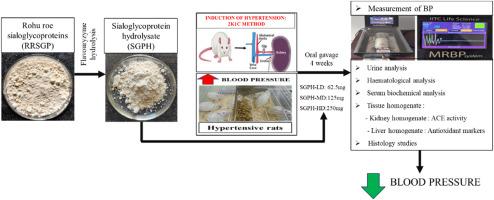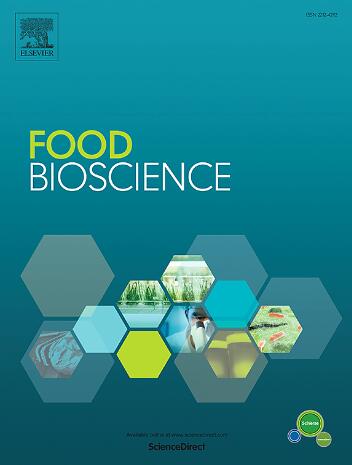Evaluation of the antihypertensive effect of sialoglycoprotein hydrolysate from Labeo rohita roes using Wistar rats
IF 5.9
1区 农林科学
Q1 FOOD SCIENCE & TECHNOLOGY
引用次数: 0
Abstract
Fish roes, rich in sialoglycoproteins, are often discarded, raising environmental concerns. The current study aimed to evaluate the antihypertensive effects of sialoglycoprotein hydrolysate produced from Labeo rohita roes using Wistar rats. SGPH exhibited moderate but significant ACE-inhibitory activity (74.70 ± 0.13 %), DPPH radical scavenging activity (37.85 ± 1.08 %), ABTS radical scavenging activity (47.15 ± 1.60 %), and FRAP activity (27.13 ± 0.03 μM Trolox equivalents/g). The ACE-inhibition kinetics and gastrointestinal (GI) digestibility of SGPH demonstrated that SGPH was a competitive inhibitor and relatively stable in simulated GI conditions. SGPH revealed a moderate but significant antihypertensive effect on hypertensive (2K1C) Wistar rats in a dose-dependent manner by reducing systolic and diastolic blood pressure (SBP and DBP) and kidney ACE activity (P < 0.05) after 4 weeks of treatment. Reduction of SBP, DBP, and kidney ACE activity ranged from 140±2–128 ± 2 mmHg, 100±3–82 ± 3 mmHg, and 0.94 ± 0.01–0.61 ± 0.02 μM HA/min/mg, respectively. Notably, SGPH elevated the superoxide dismutase and catalase activities in 2K1C rats (P < 0.05), irrespective of SGPH dose, which could augment additional cardio-protection by minimizing oxidative stress. SGPH-treated rat groups displayed urine, haematology and serum biochemistry values in the normal range, indicating no adverse effects of SGPH. Further, histopathological evaluation elucidated that there was no incidence of organ abnormality in SGPH-treated rats, asserting that SGPH precluded vital organ injuries. Therefore, SGPH could be a promising antihypertensive ingredient that can be deployed in functional foods/nutraceuticals development for combating hypertension and its related diseases.

用Wistar大鼠评价鼠唇唇糖蛋白水解物的降压作用
富含唾液糖蛋白的鱼卵经常被丢弃,引起了环境问题。本研究以Wistar大鼠为实验对象,研究了鼠血唾液糖蛋白水解物的降压作用。SGPH具有中等但显著的ace抑制活性(74.70±0.13%),DPPH自由基清除活性(37.85±1.08%),ABTS自由基清除活性(47.15±1.60%)和FRAP活性(27.13±0.03 μM Trolox等量/g)。SGPH的ace抑制动力学和胃肠道消化率表明,SGPH是一种竞争性抑制剂,在模拟胃肠道条件下相对稳定。治疗4周后,SGPH通过降低收缩压和舒张压(SBP和DBP)和肾ACE活性(P < 0.05),显示出中度但显著的降压作用,并呈剂量依赖性。舒张压、舒张压和肾ACE活性降低幅度分别为140±2 - 128±2 mmHg、100±3 - 82±3 mmHg和0.94±0.01-0.61±0.02 μ HA/min/mg。值得注意的是,无论SGPH剂量如何,SGPH都能提高2K1C大鼠的超氧化物歧化酶和过氧化氢酶活性(P < 0.05),这可能通过减少氧化应激来增强额外的心脏保护作用。SGPH处理组大鼠尿液、血液学和血清生化值均在正常范围内,表明SGPH无不良反应。此外,组织病理学评估表明,SGPH治疗的大鼠没有器官异常的发生,这表明SGPH排除了重要器官的损伤。因此,SGPH可能是一种有前景的抗高血压成分,可用于抗高血压及其相关疾病的功能食品/营养保健品的开发。
本文章由计算机程序翻译,如有差异,请以英文原文为准。
求助全文
约1分钟内获得全文
求助全文
来源期刊

Food Bioscience
Biochemistry, Genetics and Molecular Biology-Biochemistry
CiteScore
6.40
自引率
5.80%
发文量
671
审稿时长
27 days
期刊介绍:
Food Bioscience is a peer-reviewed journal that aims to provide a forum for recent developments in the field of bio-related food research. The journal focuses on both fundamental and applied research worldwide, with special attention to ethnic and cultural aspects of food bioresearch.
 求助内容:
求助内容: 应助结果提醒方式:
应助结果提醒方式:


